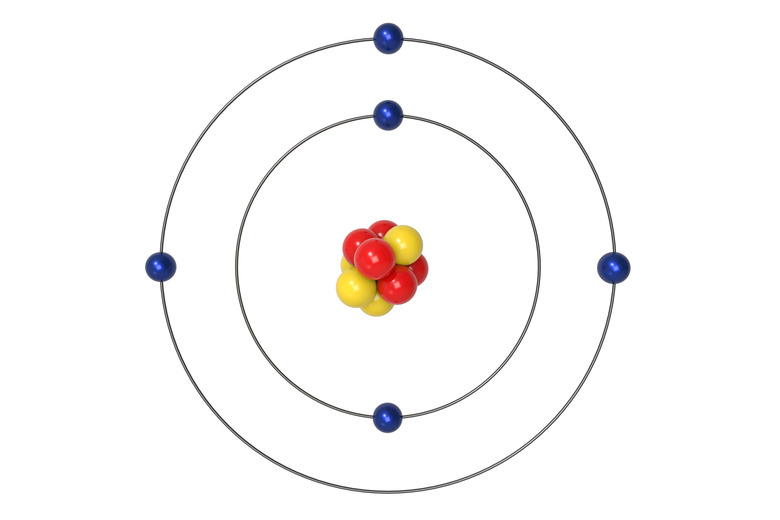How To Calculate The Number Of Atoms In A Sample
To calculate the number of atoms in a formula, the weight of a sample, its atomic mass from the periodic table and a constant known as Avogadro's number are needed.
Step 1: Find the Molar Mass of the Formula
Step 1: Find the Molar Mass of the Formula
Find a periodic table of elements to find the molar mass of your sample. If your sample is made of one element, like copper, locate the atomic mass on the periodic table. Atomic mass is usually listed below the symbol for that element.
The atomic mass of Copper is 63.55 atomic mass units. This formula mass is numerically equal to the molar mass in grams/mole, and this means copper is 63.55 grams/mole.
Whether you use an individual element like copper or a molecule, the procedure for finding the atoms in a formula remains the same.
**Example:** How many atoms are present in 32.80 grams of copper?
Find the molar mass of copper on the periodic table: 63.55 grams/mole.
Understanding the Mole: The mole (often abbreviated as mol) listed above is a unit of measurement. If you sold eggs, you would talk about them in the dozens, not one by one.
A mole is a certain amount, too. If chemists want to speak about incredibly small atoms and molecules, an amount far greater than a dozen is needed. A mole is Avogadro's number of items: 6.022 × 1023.
- 1 mole of Cu atoms = 6.022 ×
1023 Cu atoms
- 1 mole of S atoms = 6.022 × 1023 S atoms
- 1 mole of Cu2S
molecules = 6.022 × 1023 Cu2S molecules
- 1 mole of pennies = 6.022 × 1023 pennies
To give an idea of how large this number is, 1 mole of pennies would be enough money to pay all the expenses of each country on earth for about the next billion years.
Step 2: Find the Number of Moles
Step 2: Find the Number of Moles
The example is 32.80 grams of Cu. Change that into moles using the molar mass you found in Step 1. Chemists use ratios for this calculation.
Start with what you know and add in the molar mass ratio, so the units will cancel**:**
32.80 g of Cu × 1 mol Cu / 63.55 g Cu = 0.52 mol of Cu
Step 3: Convert Moles to Atoms Using Avogadro’s Number
Step 3: Convert Moles to Atoms Using
Avogadro's Number
Once the amount of moles is known, the number of atoms in the formula may be calculated using Avogadro's number. Again, use the ratio format.
Notice the number of moles is used from Step 2 to start the calculation from moles to atoms:
0.52 mol of Cu × **6.022 x 1023 atoms** / 1 mol of Cu **= 3.13 x 1023 molecules**
To answer your example question, there are 3.13 × 1023 atoms in 32.80 grams of copper.
Steps 2 and 3 can be combined. Set it up like the following:
32.80 g of Cu × 1 mol Cu / 159.17 g Cu × 6.022 x 1023 atoms / 1 mol of Cu = 3.13 x 1023 atoms in 32.80 grams of copper
Several online sites have a number of atoms calculator. One is the Omni Calculator and is listed in the Resources section, but you'll still need to know how to calculate molar mass (Step 1).
Historical Note: Why Is It Called Avogadro's Number?
Historical Note: Why Is It Called Avogadro's Number?
Avogadro's number is named after Amedeo Avogadro (1776-1856), an Italian scientist that hypothesized that equal volumes of gases at the same temperature and pressure will have the same number of particles.
Avogadro did not propose the constant, 6.022 ×1023, but because of his contributions to science, the constant was named after him. Incidentally, Avogadro first introduced his gas theory in 1811, and it was ignored for 50 years.
Cite This Article
MLA
Kozlowski, Rosann. "How To Calculate The Number Of Atoms In A Sample" sciencing.com, https://www.sciencing.com/calculate-number-atoms-sample-8242059/. 7 February 2020.
APA
Kozlowski, Rosann. (2020, February 7). How To Calculate The Number Of Atoms In A Sample. sciencing.com. Retrieved from https://www.sciencing.com/calculate-number-atoms-sample-8242059/
Chicago
Kozlowski, Rosann. How To Calculate The Number Of Atoms In A Sample last modified March 24, 2022. https://www.sciencing.com/calculate-number-atoms-sample-8242059/
